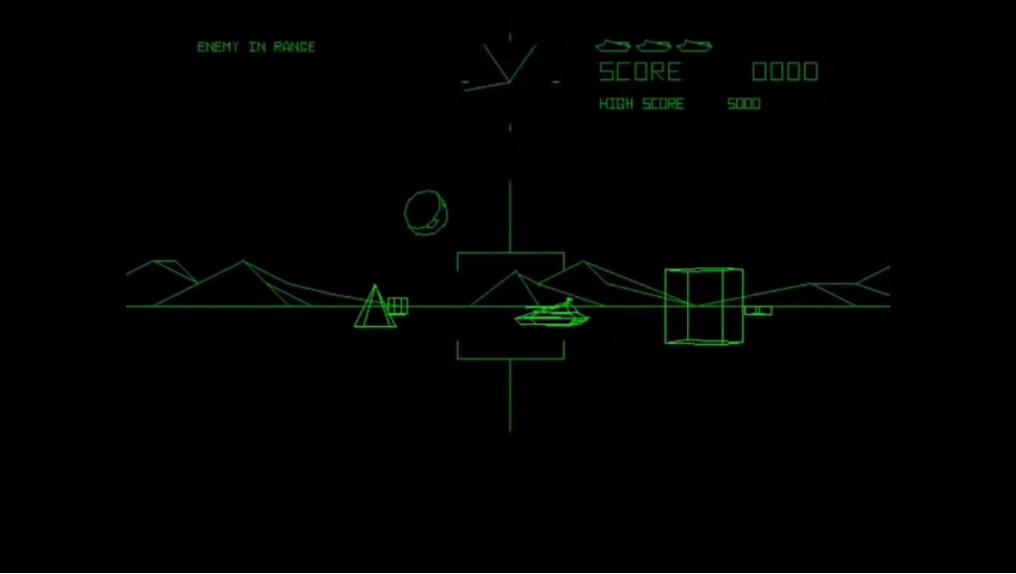- April 17, 2023
3D modeling for video games

If you want to see the revolutionary progress in the Video Games industry that is made by the introduction of 3D modeling, just think back to the times when 2D was the top technology. It started in 1940. However, the industry evolved very fast. Sources will state that the first game to use 3D graphics was Battlezone introduced already in 40 years.
Here is how it looked back in 1980.

The 21-st century brought with it a fresh inhale of development. Today, the gaming industry is showing gigantic growth rates. Modern games are not complete without 3D models. Game designers collaborate with creative teams of artists and programmers to push the boundaries of the imagination and create amazing animated images using the latest technology. Using 3D game modeling for video games they create models that are found not only as game characters – they can be trees, mountains, and houses. 3D modeling for gaming assets and characters is able to create almost real figures that make gaming look like a live environment. 3D models implement almost any idea of the authors and create entire game worlds.

Let’s dive in and see how 3D modeling in games takes the industry to the next level.
Gaming Market Overview and Key Trends
According to a report by Mordor Intelligence, in 2020 the global gaming market was valued at over US$173 billion, and it is expected to come to a value of US$314.4 billion by 2026. This means a compound annual growth rate of 9.64% over the period of 2021-2026.
- In April 2020, the number of subscribers of Xbox Game Pass crossed the line of 10 million (reported by Microsoft Corp.)
- 5G accelerates the growth pace of the VR gaming market. In May 2020, the partnership between Archiact and Migu (a subsidiary of China Mobile) will contribute to the development of VR games to be played via the 5G cloud gaming platform provided by Migu.
- According to NewGenApps, by 2025, the global user base of AR and VR games is expected to reach 216 million users. According to a global poll of technology company executives, investors, and startup founders, about 59 percent of the respondents say that gaming will have a major volume in the investment aimed at the development of VR technology.
- Gaming consoles are being updated and upgraded constantly. The market’s prominent vendors unveiled their products’ portfolio:
– Sony Interactive Entertainment (SIE) – PC port for Horizon Zero Dawn and Death Standing, as well as PlayStation 5 release,
– Microsoft – XBOX Series X and XBOX Series S,
– Nintendo – Nintendo Switch Lite.
The gaming industry is constantly evolving, and the trends include smartphones, AR/VR technologies, and more.
- Globally, in 2020, there were around 1.5 million mobile game players recorded. This growing demand for mobile games directly results from a number of technological upgrades such as AR, VR, cloud gaming, and 5G.
- According to Ericsson, 5G mobile subscriptions in the APAC region are expected to top 1,5 million by 2025.
- According to ResearchAndMarkets, the global AR gaming market reached a value of US$ 4.7 Billion in 2020. Looking ahead, by 2026 the source forecasts the global AR gaming market to come to a value of US$ 28.60 Billion.
3D modeling technologies and software for video games
Like any promising field of computer technology, 3D graphics is represented by a very extensive set of software. There are packages narrowly focused on a specific area of application of 3D graphics: special effects in cinema and on television, character animation, simulation for games, photorealistic rendering, production of full-length computer films.
Software developers try to achieve the versatility of their package. The development time, costs, and quality of the future products depend on how the engineering team is equipped and what tools are used by designers in the development stage. Computer-aided design (CAD) systems enable to reduce time and costs, as well as get a quality product.
Now there are many different programs that allow you to create a full-fledged 3D model for a particular task. Let’s talk about the most popular ones, which are also suitable for beginners.
Blender is the most popular tool in the community. There are three reasons for this – the most active users (the forum is incredibly lively), the largest toolkit, and free open source distribution.
SketchUp is the second most popular tool. A huge number of functions, a simple and intuitive interface, as well as a free version.
3DS Max is a full-fledged 3D modeling software. Rendering, animation, and the models themselves are available. Well implemented particle system.
One of the most known and widespread CAD systems is AutoCAD. This system is known to everyone who works in the field of design. Autodesk Inventor is a versatile 3D modeling package from AutoDesk, the developer of AutoCAD.
Ideally, beginners should start working with simple software to understand their needs. Taking a professional tool right away is not the best idea. Modeling is not everyone’s cup of tea. So rather than spend a lot of time developing a 3D model yourself you can order it right away. Find a large variety of such ready-made 3D parametric models in the online marketplaces or create by yourself.
Designing parametric models for games
If we consider the gaming industry and what may be indirectly connected with it then the following areas of 3D graphics stand out:
- Modeling for computer and mobile games (characters, interface, textures)
- Modeling for movies and cartoons (cut scenes)
- Working on independent projects (full game)
- Working on VR / AR projects
- Working on game design
- Rendering illustrations from 3D models
The main task of modeling is to eliminate possible errors and inaccuracies in the process of developing design documentation for any product. This is achieved by computer modeling of individual parts and their interactions in the assembly.
Parametric modeling is a method of creating things or systems that model component properties and real-world behavior using a computer. To manipulate the system properties, parametric models employ feature-based, solid, and surface modeling design tools. One of the most essential properties of parametric modeling is that interconnected attributes modify their features automatically. To put it another way, parametric modeling allows the designer to describe entire classes of shapes rather than individual examples.
Designers had a difficult time altering shapes before parametrics came around. To change the length, breadth, and height of a 3D solid, for example, the designer had to adjust the length, breadth, and height. Nevertheless, with parametric modeling the designer only needs to change one parameter; the other two are updated automatically. As a result, parametric models concentrate on the phases involved in the creation of a shape and parameterize them.
This is extremely beneficial to product design engineering service providers. However, if you want to save time, or currently don’t have the necessary software at hand, there is a solution!


